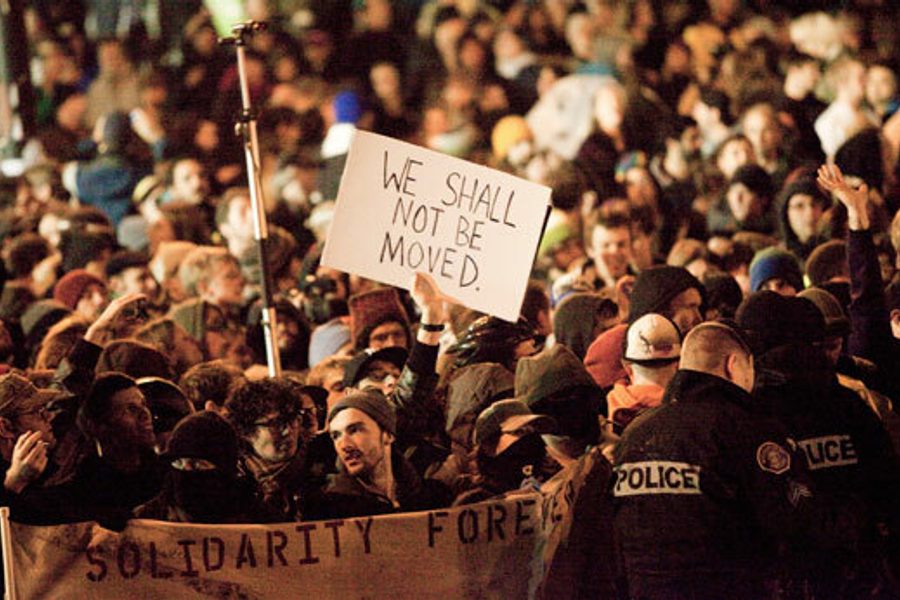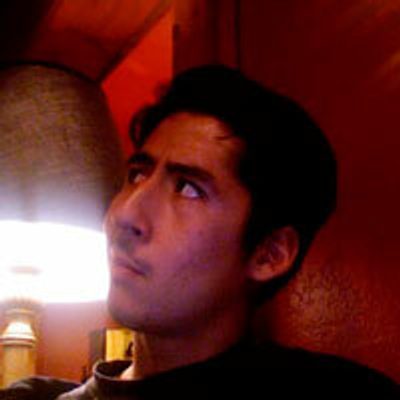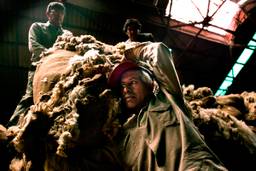
PORTLAND—Helicopter blades and drum beats pulsated here early Sunday morning, as police in riot gear formed lines around Lownsdale and Chapman Squares in the city’s center. Several thousand protesters and several hundred police engaged in a stand-off after Portland Mayor Sam Adams ordered the Occupy Portland movement to evacuate the parks bordering City Hall and the Portland Police Department by 12:01 a.m. on November 13. By 10 a.m., police had dismantled the Occupy camp.
“Everybody who is here is voting for the occupation,” Mary Hepburn, a student at Reed College, said early Sunday morning, as protesters challenged the evacuation order. “Being present is a vote and this is when your vote means the most.“
People crowded the streets and sidewalks with signs, screaming chants as cyclists (more than 100 riders) formed “bike swarms” that rode around the squares to protect the occupiers from eviction. Several youth climbed the fountain between Lownsdale and Chapman Squares and sat on the statue of a stag, which served as the symbolic epicenter of the occupation. Drum circles and dancing broke out throughout the park.
Among the crowd were union members wearing purple SEIU shirts and yellow UFCW shirts. “There’s a lot rank and filers here today,” said Glenn Kirkindall, a UFCW member. “I’m here to encourage other union members to come out and say labor opposes police brutality.” Several local unions have expressed sympathy with the Portland Occupy movement. Laborers Locals 483, the municipal union that maintains the city’s infrastructure including the parks, drafted a statement stating the union stood in solidarity with occupiers. The International Union of Painters and Allied Trades Local 10 also passed a resolution annoucning its support.
Mayor Adams announced in a press conference on Thursday November 10 that Portland police would clear the parks because of drug use and violence.
“Crime, especially reported assaults, had increased in the area, and around the camps,” Adams said. By evicting Occupy Portland from the park, Adams claimed he would be putting an end to “public safety, health, and crime problems. “
The camp existed for six weeks before Adams ordered its dismemberment. The crowd refused to abide by Adams’ deadline to evacuate the park. At 1:45 a.m., horse mounted police attempted to enter the park, only to be repelled by crowds of protesters standing in Southwest Main, between Lawnsdale and Chapman park. Portland Police Department announced on a PA truck that if the protestors did not clear the streets chemicals agents could be used. Individuals on the sidewalks and streets flashed peace signs with their fingers and screamed “Peaceful Protest.” Several youth held an American flag, as a crowd surged behind them toward the police line, moving the line back to Southwest 3rd and Southwest Madison.
“They can’t move us if we all stay put,” said one Occupy Portlander with a megaphone, elevating herself on a light post next to the street.
Police and protestors stood off into the morning. At 6 a.m., the occupiers still maintained control of the park—and some within the Occupy Portland claimed victory. Adams responded on Sunday morning that his intention was to see law and order was restored and gave no time line when this would occur. Portland police then dismantled the camp at 9:30 a.m.—once many of the protestors had left.
“The City of Portland has a problem with homelessness, alcohol and drug abuse, and the city’s solution is just to shove them in housing,” says Larry Bishop, a medical volunteer with Occupy Portland. “When the movement started we welcomed and gave the homeless a safe space and food, but I see this as punishing us for their (city’s) own policies.”
According to the Occupy Portland website, the movement will relocate its General Assembly to Pioneer Square.
Adam Case, a former In These Times editorial intern, is a San Diego-based I.W.W. organizer and freelance writer. He has traveled extensively throughout Latin America, encountering guerrillas, intellectuals and change-makers. But most of the time he tries to indulge his passions, which include surfing, social justice and a good Philly Cheesesteak.



